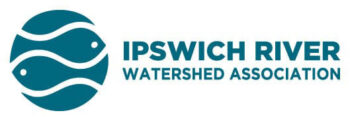The “Before and After Paddle Series” was created because the impact made on the river by summer conditions can often go unnoticed. Those intimately familiar with the river expect to do little paddling in August and September, and hope for mild weather in October to get in a few last trips before the season ends. Those who do get out on the river in those drier months often find themselves having to portage or slog through mud.
If, however, your primary experience with paddling the Ipswich River has been traversing a few choice stretches in June and July, you may not be aware of the way the river changes from spring to fall. Summer means higher temperatures, decreased rainfall and an increase in outdoor water use. In this paddle series, a group paddled the same stretch of river, upriver from Salem Road to Rowley Bridge Road, at the end of June, and then again at the end of August, experiencing the difference made on the river by two months of summer.
This graph shows how the river fluctuated between periods of heavy rain over the course of the summer.JUNE PADDLE
When RiverWatch monitors Loring Bradlee and Janet Stone took their readings on June 24th, the river had a depth of 2.1 feet, a drop of about two feet from the May 20th reading. It hadn’t taken long for the level to fall. Just four weeks after the May reading, the lower water made obstacles of some blow downs during the Grand Wenham Canal race at Paddle-a-thon 2018. Then the torrential rains that came in the week following the June readings shot the river back up to the May level for the June 29th “Before” paddle. When the RiverWatch monitors returned for their July reading, however, the level was back down to 2.6 feet!
Between the time of the two paddles, weather conditions were mixed. There were longer periods of high temperatures than we’re accustomed to in New England, but also a good deal of rain. The rains kept the ground fairly wet throughout the summer, but the high temperatures meant that certain summer behaviors were prolific.
When the sun is out and temperatures are high, it’s natural for people and animals to need rehydration. That thinking often gets carried over to our lawns and plants. However, yards only need an inch of rain a week to stay healthy. This August, we received 7.2 inches of rainfall overall, an average of over 1.4 inches a week. Add to that the high humidity levels, which equals wet, dewy lawns at night and in the morning. Humid air may make the heat seem worse to humans, but plants (as we know from greenhouses) love it and can pull that moisture from the air.
AUGUST PADDLE
The summer’s wet conditions meant that everyone’s lawn and garden would have had a spectacular year with minimal upkeep, and yet many sprinklers stayed on. On the “After” paddle, the difference in the river from the spring paddle was easily seen. Channels were less navigable, and blow downs that had been hidden were now above the surface. On the partially submerged logs, water lines and still damp aquatic plants indicated that, only recently, these had been more fully underwater. Indeed, another slew of heavy rain had brought the river to a 4.2 foot depth just a week before, higher even than the May reading. Just one hot week had brought the levels back down.
Certainly, the rain we’ve had throughout the summer has helped the water levels. Perhaps the increased rainfall also encouraged some to turn their sprinklers off. We hope so. Even a week without rainfall can make a big impact on the river.
The river’s shady meanderings can be a wonderfully refreshing reprieve from the summer swelter. To ensure that it remains navigable and enjoyable we ask everyone in the watershed to conserve water and encourage others to as well.
Next summer will likely be full of more weeks of extreme heat, but only time will tell if there will be rain or drought. The only control we have over how paddle ready our river will be is how much water we choose to take from it.
